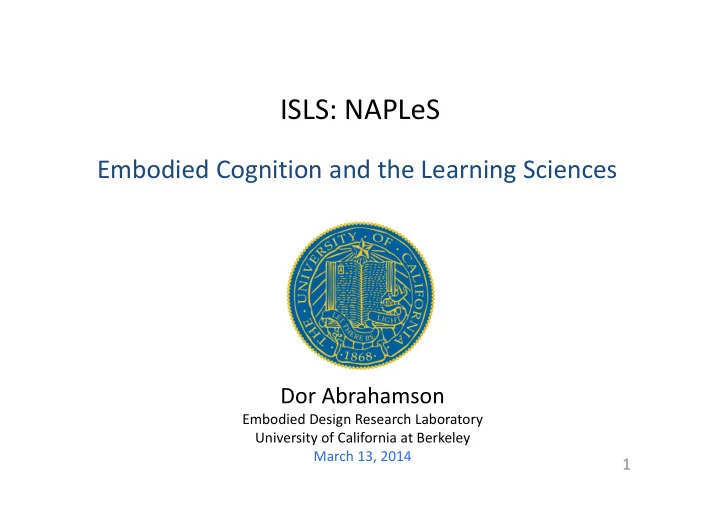

ISLS: NAPLeS Embodied Cognition and the Learning Sciences Dor Abrahamson Embodied Design Research Laboratory University of California at Berkeley March 13, 2014 1
Old Paradigm: GOFAI* 2 *Good Ol’ Fashioned Artificial Intelligence
Several Sample Empirical Findings Lick, Pick, & Kick (Hauk, Johnsrude, & Pulvermüller, 2004) • cognitive neuropsychology – event-related fMRI – passive reading of motor verbs activated corresponding neural motor regions – • The sinister QWERTY effect (Jasmin & Casasanto, 2012) – cognitive psychology – participants rate the “negative” vs. “positive” quality of affect-neutral words – judgments correlated with ratio of left/right keyboard characters in words! Formal symbols as diagrams (Landy & Goldstone, 2007; Golstone et al., 2009) • “3 x 4 + 5” is easier to parse than “3 x 4+5” – Solve “2 x x + 1”… while background dynamical images flow toward right or left – 4 = 3 + moving x in direction of background flow easier than against flow – “symbolic reasoning is more visual than is usually proposed.” – Balancing for Justice (Antle, Corness, Bevans, 2013) • – participants make judgments about social equity issues – they input their judgments using either whole-body tilt or manual controller – interaction impact on equity disposition: whole-body > manual controller ASSIGNMENT: What are possible implications of this line of work for educational theory and practice? Consider, e.g., issues of instructional materials, activities, and content. 3
Embodied Interaction for Content TRAINING • Jumping by numbers (Cress et al., ICLS 2010) – number-size judgment task, e.g., is “5” lesser (left) or greater (right) than “8”? • judgment Input is either whole-body (jump left/right) or manual (mark up/down) • interaction impact on post-test fluency: whole-body > manual controller • – Motion Math (Adauto & Klein, 2010) • engaging tablet activity for improving fraction-size estimation heuristics • an a/b fraction symbol-zoid pops up at the top of the screen, then descends • tilt the tablet to land the zoid at diagrammatically appropriate location on number line • LEARNING – Mathematical Imagery Trainer for Proportion • Abrahamson et al. (2008-2014) project “Kinemathics” • case of “embodied design” (Abrahamson 2009, 2013) • sensorimotor-based, discovery-oriented, guided-reflection learning of new content • creating conditions for the emergence of a new sensorimotor scheme • initially, no content-related cues, no symbols, no quantity -- only bimanual exploration ① bimanual solution to interaction problem, from local adjustments to global pattern ② progressive signification in formal semiotic register, shift in scheme, functional parity ③ coordinating manual and symbol-based solutions ASSIGNMENT: Brainstorm for any curricular content a design that follows similar 4 principles. Question: Is your proposed technological architecture transformative?
A New Paradigm Emerges (1/2) 1. ENACTIVISM a. “[M]ost of our mental and active life is of the immediate coping variety, which is transparent, stable, and grounded in our personal histories. Because it is so immediate, not only do we not see it, we don’t see that we do not see it, and this is why so few people have paid any attention to it until phenomenology and pragmatism, on the one hand, and new trends in cognitive science, on the other hand, brought it to the fore” (Varela, 1999, p. 7). b. "Let us explain what we mean by this phrase embodied action . By using the term embodied we mean to highlight two points: first, that cognition depends upon the kinds of experience that come from having a body with various sensorimotor capacities, and second, that these individual sesnorimotor capacities are themselves embedded in a more encompassing biological, psychological, and cultural context. By using the term action we mean to emphasize once again that sensory and motor processes, perception and action, are fundamentally inseparable in lived cognition. Indeed, the two are not merely contingently linked in individuals; they have also evolved together. We can now give a preliminary formulation of what we mean by enaction . In a nutshell, the enactive approach consists of two points: (1) perception consists in perceptually guided action and (2) cognitive structures emerge from the recurrent sensorimotor patterns that enable action to be perceptually guided" (Varela, Thompson, & Rosch, 1991, pp. 172-173). c. “All doing is knowing, and all knowing is doing” (Maturana & Varela, 1992, p. 26). 5
A New Paradigm Emerges (2/2) 2. ANTI-PROPOSITIONAL a. ”Abstract concepts are perceptual, being grounded in temporally extended simulations of external and internal events” (Barsalou, 1999, p. 603). 3. ANTI-REPRESENTATIONAL a. “Successful learning and action do not require propositional mental representations. They do not require semantically interpretable brain representations either” (Dreyfus, 2002, p. 367). b. "Until cognitive scientists recognize this essential role of the body, their work will remain a mixed bag of ad hoc successes and, to them, incomprehensible failures” (Dreyfus & Dreyfus, 1999, p. 118). c. “[C]ognition is to be described in terms of agent-environment dynamics, and not in terms of computation and representation” (Chemero, 2009, p. x). 4. THE CHALLENGE a. “Assuming -- as some at least do -- that even abstract concepts are originally derived from concrete sensorimotor experience, which could be the case, we would need to model this, and track this process, perhaps through developmental work, or... whatever , so... at least we need to do more than just assuming that that is taking place � (Hommel, 2011). ASSIGNMENT: Consider these quotations. Does this make sense? I mean, does thinking this way resonate with your lab’s theoretical orientations toward empirical data? If not, then could you ‘assimilate’ this thinking?.. Would it change your process in any meaningful way that bears on theory and/or practice? 6
Enduring Research Problems • What is a concept? • What is the role of the body in conceptual learning and reasoning? • How does physical activity interface with cultural forms in ways that contribute to learning? • What is the role of the teacher in this process? • What are advantages and possible limitations of a pedagogical approach based on grounded learning? • What frameworks might guide designers better to create, teachers better to facilitate grounded learning? 7
Recommend
More recommend